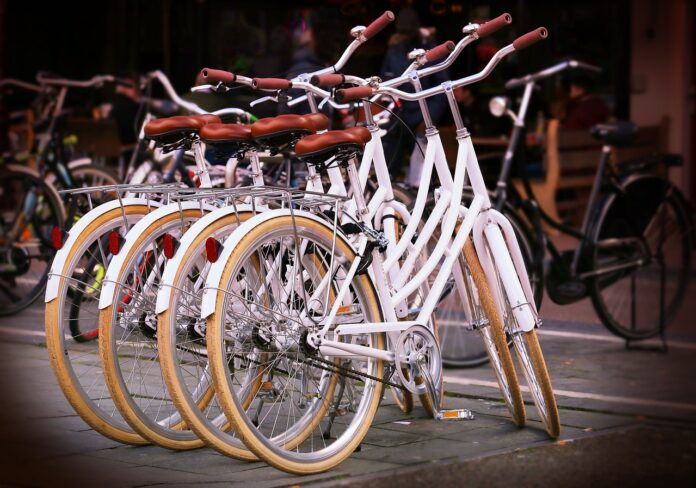Quiet country roads and crushed limestone paths along a river are usually my first choice for exploring. However, every once in a while, I have the urge to tackle a concrete jungle.
I think it’s the rich cultural heritage and historical landmarks that lure me back to the City of Bridges. I have also found that it’s easier to explore Pittsburgh on a bike than to navigate in a car.
We planned to ride bikes from the Carnegie Science Center along the river to the Carnegie Museum of Natural History on Forbes Avenue. Years ago for Christmas, we started purchasing a family membership that allows us to enter all the Carnegie museums throughout the year.
River route
We parked at the Carnegie Science Center before starting our bike trip along the Three Rivers Heritage Trail, a 33-mile trail along both banks of the Allegheny, Monongahela and Ohio Rivers. As we entered the trail, the USS Requin, a submarine built during World War II was on our right and the science center on our left.
The trail gave us a scenic view of the riverfront. We passed by the Fred Rogers Memorial Statue. Lovingly known as Mr. Rogers, he delighted generations of children with stories. His peaceful demeanor is replicated in the statue overlooking the river.
As we continued on the trail, we noticed the Vietnam Veterans’ Monument up ahead of us. The canopy over the statues is shaped like a hibiscus flower, a symbol of rebirth and regeneration. Wind chimes hang from the ceiling; the musical tones are in remembrance of the men and women lost in the war. The statues depict soldiers returning home to their families following the war.
Riding across the Fort Duquesne Bridge on the pedestrian path, we took in views along the Allegheny River. My fear of heights was tested. I could handle looking out, but not straight down.
Bright orange, muted yellow and fading green trees surrounded the Duquesne Incline as we made our way to Point State Park. The park is located at the confluence of the three rivers and is considered Pittsburgh’s “Golden Triangle.” Visitors to the park can take in views along the river and learn about significant historical events. The park preserves the heritage of the area and its importance during the French and Indian War.
From the park, we headed along the Monongahela River toward our destination of Schenley Park. Improved signs and bright green painted trail markers helped us find our way from the Three Rivers Heritage Trail to the Eliza Furnace Trail.
Ginkgo
We zipped along on the bike trail noticing young trees protected from wildlife with PVC piping. Unique ginkgo trees formed a tunnel, separating us from the city. The bright yellow, fan-shaped leaves of the ginkgo trees were the first feature that caught my attention. I stopped pedaling and walked over to take a closer look.
Without realizing it, I was stepping on fallen berries on the ground. Right then, a smell hit me like a truck. There had to be a dead animal somewhere. We started discussing whether or not the smell could be from the berries. It was.
We were schooled right then on one of the only disadvantages of a ginkgo tree. Some plants have both male and female parts. However, ginkgo trees are either male or female. The berries produced by the female tree create a horrid odor. The males do not produce fruit.
Originally from China, the trees are believed to live for thousands of years. Some scientists believe dinosaurs might have roamed under ginkgo trees. The trees are very hardy, thriving in cities despite low air quality and limited space. After the atomic bomb was dropped on Hiroshima, six ginkgo trees survived the decimation.
We jumped back on our bikes and pedaled out of the stench. After taking the Eliza Furnace Trail, we crossed over railroad tracks into Panther Hollow, a part of Schenley Park. The weather was perfect and many students were exploring the park. It borders Carnegie Mellon University and the University of Pittsburgh.
Once we reached the art museum after riding just over 7 miles, we locked up our bikes and went inside. I thought I had the museum memorized, but I found a hallway of miniatures that I had never seen before. We ended our quick tour with hot coffee in the cafe before heading back out on the trail.
As much as I prefer the quiet solitude of a walk in the woods, I surprisingly enjoyed our day in Pittsburgh. Just as the ginkgo tree is a survivor, the City of Steel is a survivor adapting to the needs of a changing world. Outdoor recreational opportunities are paving the way to a bright future.














What a great bike tour! I love biking around the city too. The Ginkgo tree really does have a terrible smell but I find the leaves to be quite delicate and beautiful. I had no idea they could live for thousands of years! That’s pretty amazing. Thank you for the post.